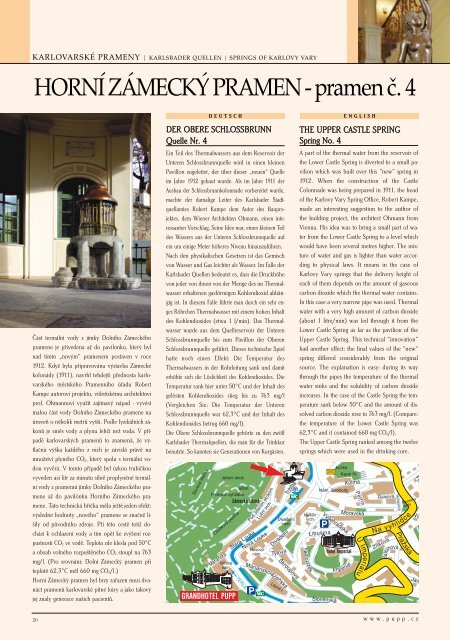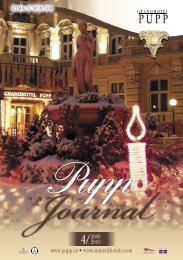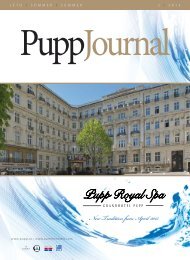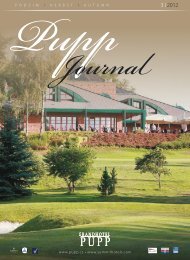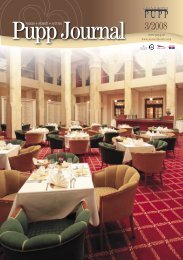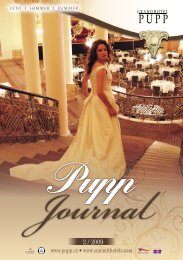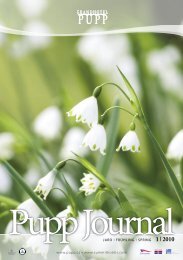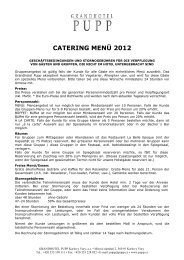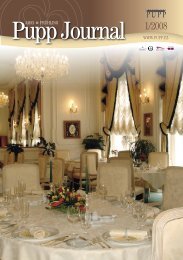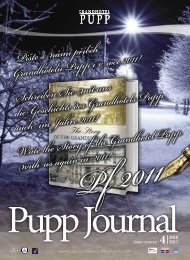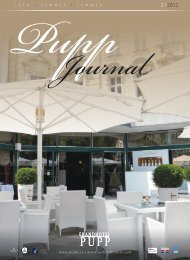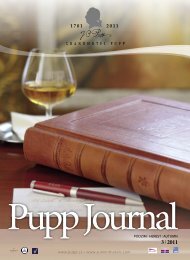Pupp Journal Zima 2007 - Grandhotel Pupp
Pupp Journal Zima 2007 - Grandhotel Pupp
Pupp Journal Zima 2007 - Grandhotel Pupp
Sie wollen auch ein ePaper? Erhöhen Sie die Reichweite Ihrer Titel.
YUMPU macht aus Druck-PDFs automatisch weboptimierte ePaper, die Google liebt.
KARLOVARSKÉ PRAMENY | KARLSBADER QUELLEN | SPRINGS OF KARLOVY VARY<br />
HORNÍ ZÁMECKÝ PRAMEN - pramen č. 4<br />
Část termální vody z jímky Dolního Zámeckého<br />
pramene je přivedena až do pavilonku, který byl<br />
nad tímto „novým“ pramenem postaven v roce<br />
1912. Když byla připravována výstavba Zámecké<br />
kolonády (1911), navrhl tehdejší přednosta karlovarského<br />
městského Pramenního úřadu Robert<br />
Kampe autorovi projektu, vídeňskému architektovi<br />
prof. Ohmannovi využít zajímavý nápad - vyvést<br />
malou část vody Dolního Zámeckého pramene na<br />
úroveň o několik metrů vyšší. Podle fyzikálních zákonů<br />
je směs vody a plynu lehčí než voda. V případě<br />
karlovarských pramenů to znamená, že výtlačná<br />
výška každého z nich je závislá právě na<br />
množství plyného CO 2, který spolu s termální vodou<br />
vyvěrá. V tomto případě byl úzkou trubičkou<br />
vyveden asi litr za minutu silně proplyněné termální<br />
vody z pramenní jímky Dolního Zámeckého pramene<br />
až do pavilónku Horního Zámeckého pramene.<br />
Tato technická hříčka měla ještě jeden efekt:<br />
výsledné hodnoty „nového“ pramene se značně lišily<br />
od původního zdroje. Při této cestě totiž dochází<br />
k ochlazení vody a tím opět ke zvýšení rozpustnosti<br />
CO 2 ve vodě. Teplota zde klesla pod 50°C<br />
a obsah volného rozpuštěného CO 2 stoupl na 763<br />
mg/l. (Pro srovnání: Dolní Zámecký pramen při<br />
teplotě 62,3°C měl 660 mg CO 2/l.)<br />
Horní Zámecký pramen byl brzy zařazen mezi dvanáct<br />
pramenů karlovarské pitné kúry a jako takový<br />
jej znaly generace našich pacientů.<br />
DER OBERE SCHLOSSBRUNN<br />
Quelle Nr. 4<br />
Ein Teil des Thermalwassers aus dem Reservoir der<br />
Unteren Schlossbrunnquelle wird in einen kleinen<br />
Pavillon zugeleitet, der über dieser „neuen“ Quelle<br />
im Jahre 1912 gebaut wurde. Als im Jahre 1911 der<br />
Ausbau der Schlossbrunnkolonnade vorbereitet wurde,<br />
machte der damalige Leiter des Karlsbader Stadtquellamtes<br />
Robert Kampe dem Autor des Bauprojektes,<br />
dem Wiener Architekten Ohmann, einen interessanten<br />
Vorschlag. Seine Idee war, einen kleinen Teil<br />
des Wassers aus der Unteren Schlossbrunnquelle auf<br />
ein um einige Meter höheres Niveau hinauszuführen.<br />
Nach den physikalischen Gesetzen ist das Gemisch<br />
von Wasser und Gas leichter als Wasser. Im Falle der<br />
Karlsbader Quellen bedeutet es, dass die Druckhöhe<br />
von jeder von ihnen von der Menge des im Thermalwasser<br />
erhaltenen gasförmigen Kohlendioxid abhängig<br />
ist. In diesem Falle führte man durch ein sehr enges<br />
Röhrchen Thermalwasser mit einem hohen Inhalt<br />
des Kohlendioxides (etwa 1 l/min). Das Thermalwasser<br />
wurde aus dem Quellreservoir der Unteren<br />
Schlossbrunnquelle bis zum Pavillon der Oberen<br />
Schlossbrunnquelle geführt. Dieses technische Spiel<br />
hatte noch einen Effekt: Die Temperatur des<br />
Thermalwassers in der Rohrleitung sank und damit<br />
erhöhte sich die Löslichkeit des Kohlendioxides. Die<br />
Temperatur sank hier unter 50°C und der Inhalt des<br />
gelösten Kohlendioxides stieg bis zu 763 mg/l<br />
(Vergleichen Sie: Die Temperatur der Unteren<br />
Schlossbrunnquelle war 62,3°C und der Inhalt des<br />
Kohlendioxides betrug 660 mg/l).<br />
Die Obere Schlossbrunnquelle gehörte zu den zwölf<br />
Karlsbader Thermalquellen, die man für die Trinkkur<br />
benutzte. So kannten sie Generationen von Kurgästen.<br />
k<br />
Sovova stezka<br />
DEUTSCH<br />
Jelení skok<br />
altán<br />
Petrova vyhlídka<br />
Chotkova pû‰ina<br />
Mírové<br />
nám.<br />
Mariánská<br />
GRANDHOTEL PUPP<br />
Zámecké Lázně<br />
Stará Louka<br />
TEPLÁ<br />
Luãní vrch<br />
Pod Jelením skokem<br />
Nová Louka<br />
Husovo<br />
nám.<br />
Láznû I.<br />
Divadelní<br />
nám.<br />
Divadelní<br />
Tylova<br />
MariánskolázeÀská<br />
·kroupova<br />
G<br />
ská<br />
TrÏi‰tû<br />
THE UPPER CASTLE SPRING<br />
Spring No. 4<br />
A part of the thermal water from the reservoir of<br />
the Lower Castle Spring is diverted to a small pavilion<br />
which was built over this “new” spring in<br />
1912. When the construction of the Castle<br />
Colonnade was being prepared in 1911, the head<br />
of the Karlovy Vary Spring Office, Robert Kampe,<br />
made an interesting suggestion to the author of<br />
the building project, the architect Ohmann from<br />
Vienna. His idea was to bring a small part of water<br />
from the Lower Castle Spring to a level which<br />
would have been several metres higher. The mixture<br />
of water and gas is lighter than water according<br />
to physical laws. It means in the case of<br />
Karlovy Vary springs that the delivery height of<br />
each of them depends on the amount of gaseous<br />
carbon dioxide which the thermal water contains.<br />
In this case a very narrow pipe was used. Thermal<br />
water with a very high amount of carbon dioxide<br />
(about 1 litre/min) was led through it from the<br />
Lower Castle Spring as far as the pavilion of the<br />
Upper Castle Spring. This technical “innovation“<br />
had another effect: the final values of the “new“<br />
spring differed considerably from the original<br />
source. The explanation is easy: during its way<br />
through the pipes the temperature of the thermal<br />
water sinks and the solubility of carbon dioxide<br />
increases. In the case of the Castle Spring the temperature<br />
sank below 50°C and the amount of dissolved<br />
carbon dioxide rose to 763 mg/l. (Compare:<br />
the temperature of the Lower Castle Spring was<br />
62,3°C and it contained 660 mg CO 2/l).<br />
The Upper Castle Spring ranked among the twelve<br />
springs which were used in the drinking cure.<br />
HálkÛv<br />
vrch<br />
Nebozízek<br />
Slovenská<br />
koãka<br />
Karel IV.<br />
Nám. Svobody<br />
Libu‰ina<br />
Vy‰ehradská<br />
hotel Imperial<br />
ENGLISH<br />
Imperial<br />
Kolmá<br />
Petfiín<br />
Moravská<br />
U<br />
Imperiálu<br />
Raisova<br />
Zítkova<br />
Balb<br />
Hynaisova<br />
Na vyh<br />
ínova<br />
PraÏská<br />
Füg<br />
Resslovy<br />
sady<br />
lídceN a<br />
N<br />
Jarn<br />
20 www.pupp.cz


